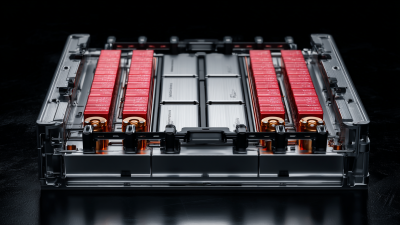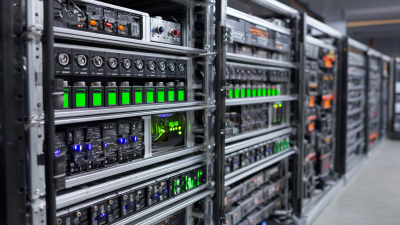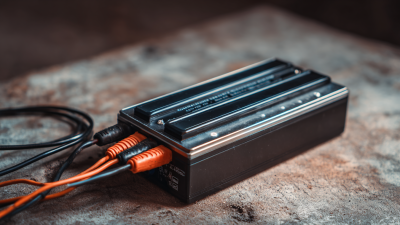How to Choose the Right Li Ion Inverter for Your Energy Needs
Table of Contents
- Understanding the Basics of Li-Ion Inverters for Home Energy Needs
- Evaluating Your Power Requirements: Sizing Your Li-Ion Inverter
- Key Features to Look for in the Best Li-Ion Inverters Available Today
- Comparing Leading Brands: Which Li-Ion Inverter Stands Out?
- Cost vs. Performance: Finding Value in Li-Ion Inverters
- Installation and Maintenance Tips for Optimal Inverter Performance
- FAQS
- Conclusion
- Related Posts
In today's rapidly evolving energy landscape, the importance of selecting the right Li Ion Inverter has never been more critical. With advancements in lithium battery technology, particularly those spearheaded by industry leaders like Roofer Electronics Technology (Shanwei) Co., Ltd., which boasts over 27 years of expertise in R&D, manufacturing, and solution services, consumers are now empowered to make informed choices. According to recent industry reports, the global lithium-ion battery market is projected to reach $129.3 billion by 2027, reflecting a compound annual growth rate (CAGR) of 20.3% from 2020 to 2027. This surge emphasizes the necessity for reliable energy storage solutions across various applications, ranging from household energy systems to electric bicycles. Understanding how to choose the right Li Ion Inverter will enable users to optimize their energy needs, ensuring efficiency and sustainability in their energy consumption.

Understanding the Basics of Li-Ion Inverters for Home Energy Needs
When selecting a lithium-ion (Li-Ion) inverter for home energy needs, understanding the fundamental characteristics of these devices is crucial. Li-Ion inverters convert the stored energy from lithium-ion batteries into usable AC power for household appliances. According to a report from the International Energy Agency (IEA), the global market for Li-Ion batteries is expected to grow at a CAGR of 10.4% between 2021 and 2026, reflecting a rising demand for energy-efficient solutions.
Key factors to consider include the inverter’s capacity, efficiency, and compatibility with existing solar power systems. An inverter rated for a higher continuous output can handle more appliances simultaneously. The U.S. Department of Energy states that high-efficiency inverters can achieve over 95% energy conversion, minimizing wasted energy and improving overall system performance. Additionally, ensuring that the inverter is compatible with specific battery types and renewable energy sources can greatly enhance its effectiveness and longevity, leading to more sustainable energy consumption in your home.

Evaluating Your Power Requirements: Sizing Your Li-Ion Inverter
When it comes to choosing the right lithium-ion (Li-Ion) inverter, understanding your power requirements is crucial. Start by evaluating the total wattage of all the devices you plan to connect. This includes lights, appliances, and other electronics. A practical approach is to list each device’s wattage and calculate the combined total. This figure will help you determine which inverter size will effectively meet your energy needs without overloading or wasting power.
**Tip:** Always factor in growth for future energy demands—if you plan to add more devices down the line, opt for an inverter with a slightly higher capacity than your current needs. Additionally, consider the surge power requirements of your devices, especially for tools and appliances that need extra power upon startup. Generally, you should choose an inverter that can handle at least 1.5 times the surge wattage.
Lastly, think about your energy consumption habits. Do you frequently use multiple devices at once, or will they be powered one at a time? Understanding these patterns can assist you in selecting an inverter that not only powers your devices effectively but also aligns with your daily electricity usage. Proper sizing ensures optimal performance and longevity of your inverter, allowing you to harness the full benefits of your Li-Ion system.
Key Features to Look for in the Best Li-Ion Inverters Available Today
When selecting a Li-Ion inverter, it’s essential to consider key features that align with your energy needs. Firstly, assess the inverter's output capacity, typically measured in watts. According to the International Energy Agency (IEA), an average household requires between 1,500 to 3,000 watts at peak usage. A reliable inverter must comfortably handle this load to ensure seamless operation during power outages or peak times.
Another critical aspect is the inverter’s efficiency rating, which indicates how much energy is converted into usable power. Higher efficiency ratings, like those above 90%, can significantly reduce energy loss. A recent report by the National Renewable Energy Laboratory (NREL) highlighted that choosing an inverter with high efficiency can save users up to 20% on energy costs over its lifespan.
**Tip:** Always check for advanced features like battery management systems, which enhance safety by monitoring battery conditions, and consider warranties. A robust warranty often indicates the manufacturer’s confidence in their product. Moreover, look for inverters with smart functionality that allow monitoring via mobile apps, making it easier to track performance and energy consumption in real-time.
Li-Ion Inverter Capacity Comparison
Comparing Leading Brands: Which Li-Ion Inverter Stands Out?
When selecting a lithium-ion (Li-Ion) inverter, it’s essential to compare leading brands to understand which model best meets your energy needs. Industry reports indicate that the global Li-Ion inverter market is projected to grow at a CAGR of 20.4% from 2023 to 2030, driven by advancements in energy storage technology and increasing demand for renewable energy solutions. Top competitors like Victron Energy, Renogy, and Schneider Electric each offer unique features tailored to various applications, from residential to commercial use.
Victron Energy, for example, is renowned for its reliability and extensive range of products, boasting a peak efficiency of up to 94%. Meanwhile, Renogy's models stand out for their affordability and user-friendly designs, making them ideal for budget-conscious consumers and beginners. Schneider Electric, on the other hand, focuses on smart technology integration, offering systems that can be monitored and managed via mobile applications, appealing to tech-savvy users. By comparing these brands and their specifications, potential buyers can make informed choices that align with their specific power requirements and usage scenarios.

Cost vs. Performance: Finding Value in Li-Ion Inverters
When selecting a lithium-ion (Li-Ion) inverter, understanding the balance between cost and performance is crucial for ensuring you get the most value for your investment.
Li-Ion inverters can vastly differ in price due to variations in technology, efficiency, and brand reputation. While it may be tempting to opt for a more affordable option, it’s essential to consider the long-term benefits of higher-performing models. These often provide better energy conversion efficiency, longer lifespan, and enhanced features that can save you money in the long run.
Performance metrics such as output capacity, efficiency ratings, and warranty terms play a significant role in determining the right inverter for your needs. A higher upfront cost can be justified if the inverter offers superior performance, reliability, and features that reduce energy loss. Additionally, evaluating the reputation of the manufacturer and reading customer reviews can provide insights into the inverter's real-world performance, ensuring you choose a product that not only fits your budget but also meets your energy requirements effectively.
Installation and Maintenance Tips for Optimal Inverter Performance
When it comes to installation and maintenance of Li-ion inverters, attention to detail is crucial for optimal performance. According to a report by the International Energy Agency (IEA), proper installation can improve efficiency by up to 15%, which is significant given that inverters are critical in converting direct current (DC) from solar panels to alternating current (AC) for residential use. Ensuring that the inverter is installed in a well-ventilated area away from direct sunlight can help prevent overheating, which is a common issue that can lead to reduced efficiency and a shorter lifespan.
Regular maintenance is equally important. A study by the National Renewable Energy Laboratory (NREL) emphasizes that routine checks for dust and debris can significantly prolong an inverter's life. It’s advisable to inspect connections and clean filters every six months. Additionally, software updates provided by the manufacturer may enhance functionality and security, helping in quick diagnostics of performance issues. By adhering to these installation and maintenance tips, users can ensure their Li-ion inverters operate at peak capacity and effectively meet their energy needs.
How to Choose the Right Li-Ion Inverter for Your Energy Needs - Installation and Maintenance Tips for Optimal Inverter Performance
| Feature | Description | Considerations |
|---|---|---|
| Power Output | The amount of power the inverter can supply, usually measured in watts. | Ensure it's compatible with your energy consumption needs. |
| Input Voltage | The voltage needed from your battery or solar panels. | Choose the inverter that matches your system voltage, typically 12V, 24V, or 48V. |
| Waveform Type | Types include pure sine wave, modified sine wave, and square wave. | Pure sine wave is recommended for sensitive electronics. |
| Efficiency | The ratio of output power to input power. | Look for higher efficiency (above 90%) to reduce energy loss. |
| Cooling System | System designed to dissipate heat during operation. | Active cooling can improve performance and longevity. |
| Size and Weight | Physical dimensions and weight of the inverter unit. | Ensure the inverter fits your installation space without issue. |
| Safety Features | Built-in protections against overloads, short circuits, and overheating. | Safety features are essential for protecting your equipment. |
| Warranty | The period during which the inverter is guaranteed to function properly. | Longer warranties often indicate higher quality and reliability. |
FAQS
: A Li-Ion inverter converts stored energy from lithium-ion batteries into usable AC power for household appliances.
Choosing the right size is crucial to meet your energy needs without overloading the inverter or wasting power.
Evaluate the total wattage of all devices you plan to connect, and consider future energy demands and surge power requirements to choose an appropriately sized inverter.
The inverter's capacity, efficiency rating, and compatibility with specific battery types and renewable energy sources all affect its overall performance and efficiency.
According to the U.S. Department of Energy, high-efficiency inverters can achieve over 95% energy conversion, minimizing wasted energy.
Yes, it's advisable to factor in future energy demands and choose an inverter with a slightly higher capacity than your current needs to accommodate potential additions of devices.
Surge power is the extra power needed by some tools and appliances upon startup; choose an inverter that can handle at least 1.5 times the surge wattage to ensure proper functioning.
Understanding whether you use multiple devices simultaneously or on a one-at-a-time basis can help you select an inverter that aligns with your electricity usage patterns.
Compatibility with renewable energy sources enhances the inverter's effectiveness and longevity, leading to more sustainable energy consumption in your home.
The global market for Li-Ion batteries is expected to grow at a CAGR of 10.4% between 2021 and 2026, indicating a rising demand for energy-efficient solutions.
Conclusion
Choosing the right Li Ion Inverter to meet your energy needs is essential for achieving optimal efficiency and performance. Understanding the basics of these inverters is the first step, followed by evaluating your specific power requirements to ensure proper sizing. Key features—such as efficiency ratings, battery compatibility, and user-friendly interfaces—should be prioritized when selecting the best model.
Additionally, exploring leading brands can help identify standout products, while balancing cost and performance is crucial for value. Installing and maintaining your Li Ion Inverter correctly will enhance its longevity and effectiveness. With over 27 years of expertise in lithium batteries and energy storage solutions, Roofer Electronics Technology (Shanwei) Co., Ltd. is well-equipped to help guide you in making the best choice for your home energy needs.
Related Posts
-

Understanding the Industry Standards for Best 12v Lithium Iron Battery Production
-

5 Essential Tips to Maximize Efficiency with Solar Thermal Generators
-

Leading Global Manufacturer: Explore the Best 3.2v 100ah Lifepo4 Battery Cells Available Today
-

Why Lithium Iron Phosphate Batteries Stand Out Among Other Battery Technologies
-

Your Ultimate Guide to Selecting Battery Racks for Optimal Performance and Safety in Energy Storage Systems
-

How to Extend the Lifespan of Your 36v Lithium Battery: Tips and Tricks





 business@roofer.cn
business@roofer.cn +86 13502883088
+86 13502883088






